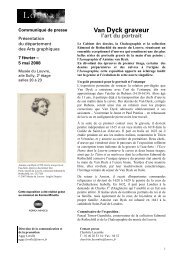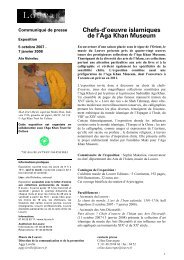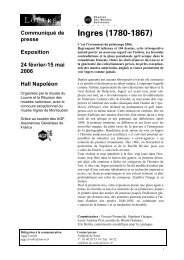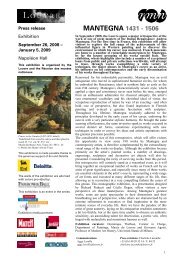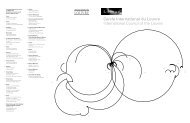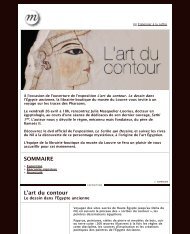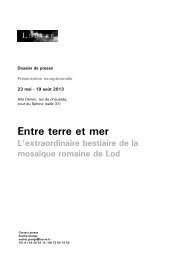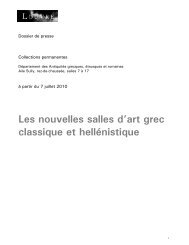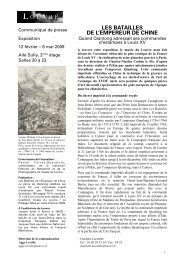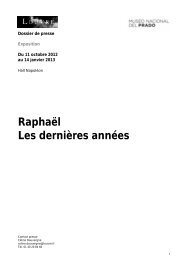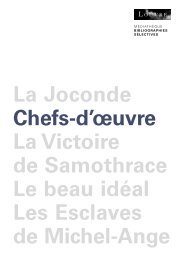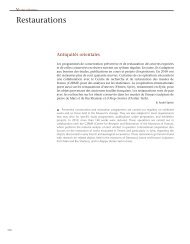Chypre - Musée du Louvre
Chypre - Musée du Louvre
Chypre - Musée du Louvre
You also want an ePaper? Increase the reach of your titles
YUMPU automatically turns print PDFs into web optimized ePapers that Google loves.
Cat. 93<br />
Vervelle ou pendant de harnachement<br />
XIV e siècle<br />
Alliage cuivreux<br />
Provenance : Nicosie, trouvaille fortuite à l’intérieur<br />
de l’enceinte de la ville en 1993<br />
Nicosie, <strong>Musée</strong> municipal Léventis<br />
Cat. 94<br />
Écusson armorié<br />
XV e siècle<br />
Cuivre et émail champlevé<br />
Provenance : <strong>Chypre</strong>. Lieu de découverte inconnu<br />
Nicosie, <strong>Musée</strong> municipal Léventis<br />
Cat. 95<br />
Guillaume de Machaut, Poésies<br />
Paris-Reims, 1372-1377<br />
Parchemin<br />
Louis de Gruuthuse, puis bibliothèque de Louis<br />
XII.<br />
Paris, Bibliothèque nationale de France, ms français<br />
1584<br />
Cat. 96<br />
Philippe de Mézières, Songe <strong>du</strong> viel pelerin<br />
Paris, fin <strong>du</strong> XIV e siècle<br />
Parchemin<br />
Bibliothèque des Célestins de Paris. Entré au<br />
XVIII e siècle dans la bibliothèque de M. de Paulmy<br />
(1722-1787).<br />
Paris, Bibliothèque de l’Arsenal, ms 2682<br />
Cat. 97<br />
Fragment dit « <strong>du</strong> suaire de Guy de Lusignan »<br />
Syrie ou Égypte, XIV e ou XV e siècle<br />
Double étoffe façonnée de soie<br />
Collection Claudius Côte à Lyon, puis David<br />
David-Weill.<br />
Paris, musée de Cluny – musée national <strong>du</strong><br />
Moyen Âge<br />
Cat. 98<br />
Bassin au nom d’Hugues de Lusignan et aux<br />
armes des Ibelin et de Jérusalem<br />
Syrie ou Égypte, vers 1324<br />
Alliage cuivreux, traces d’incrustations d’argent,<br />
d’or et de pâte noire<br />
Ancienne collection Henri-René D’Allemagne.<br />
Paris, musée <strong>du</strong> <strong>Louvre</strong><br />
Cat. 99<br />
Plateau aux armes « Lusignan ancien »<br />
Syrie ou Égypte, vers 1330-1340<br />
Alliage cuivreux, traces d’incrustations d’argent,<br />
d’or et de pâte noire<br />
Acquis en vente publique à Londres en 1999,<br />
grâce au mécénat de la fondation A. G. Leventis.<br />
Paris, musée <strong>du</strong> <strong>Louvre</strong><br />
Cat. 100<br />
Bassin à inscription hébraïque<br />
Égypte, XV e siècle (?) ou 1 re moitié <strong>du</strong> XVI e siècle<br />
Alliage cuivreux, décor gravé<br />
Provenance : <strong>Chypre</strong>, cap Akamas ( ?), découverte<br />
fortuite en 2004<br />
Nicosie, <strong>Musée</strong> municipal Leventis<br />
Cat. 101<br />
Coupe à la sphinge<br />
Syrie côtière, dernier tiers <strong>du</strong> XIII e siècle<br />
Céramique glaçurée à décor incisé sous glaçure<br />
transparente incolore et rehauts de glaçures<br />
colorés<br />
Provenance : <strong>Chypre</strong>, Limassol, découverte dans<br />
le quartier <strong>du</strong> Kastro<br />
Limassol, <strong>Musée</strong> médiéval<br />
Cat. 102<br />
Cinq fragments de carreaux de revêtement<br />
Syrie, dernier tiers <strong>du</strong> XIII e siècle<br />
Pâte siliceuse à décor peint sous glaçure alcaline<br />
transparente<br />
Provenance : <strong>Chypre</strong>, manoir de Potamia, fouilles<br />
de 2002-2003<br />
Larnaca, musée <strong>du</strong> Château<br />
Cat. 103<br />
Chapiteau de portail<br />
<strong>Chypre</strong>, première moitié <strong>du</strong> XIII e siècle<br />
Pierre<br />
Provenance : Kato Paphos<br />
Paphos, <strong>Musée</strong> archéologique<br />
Cat. 106<br />
Le Christ bénissant<br />
<strong>Chypre</strong>, fin <strong>du</strong> XIII e - début <strong>du</strong> XIV e siècle<br />
Marbre de Proconnèse<br />
Provenance : <strong>Chypre</strong>, lieu d’origine inconnu<br />
Nicosie, musées <strong>du</strong> Lycée panchypriote<br />
Cat. 111<br />
Écu au lion rampant<br />
<strong>Chypre</strong>, XIV e -XV e siècle<br />
Calcaire<br />
Provenance : <strong>Chypre</strong>, sans lieu précis<br />
Nicosie, <strong>Musée</strong> d’art populaire



